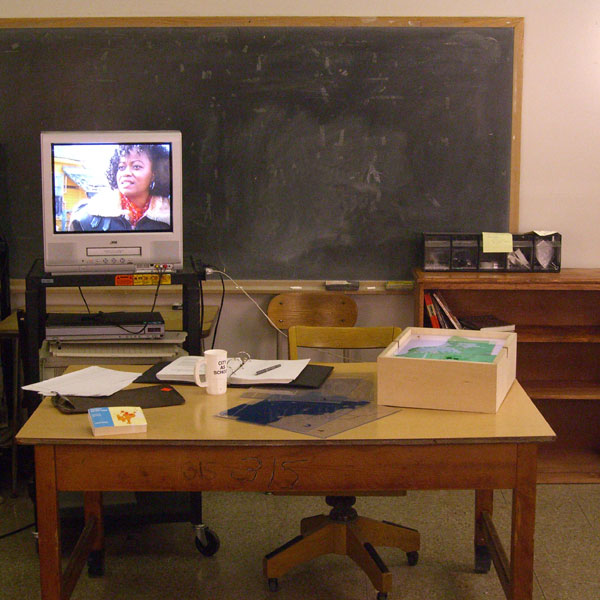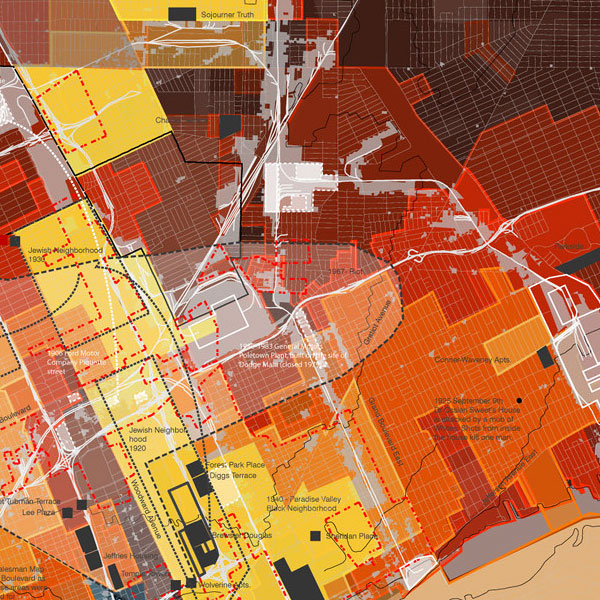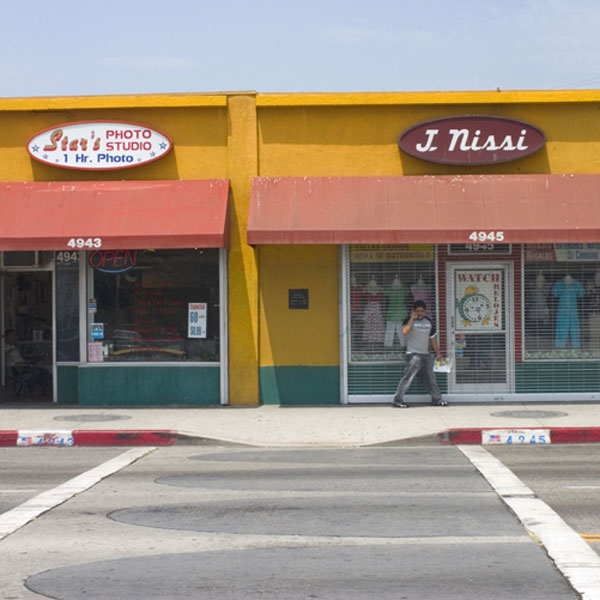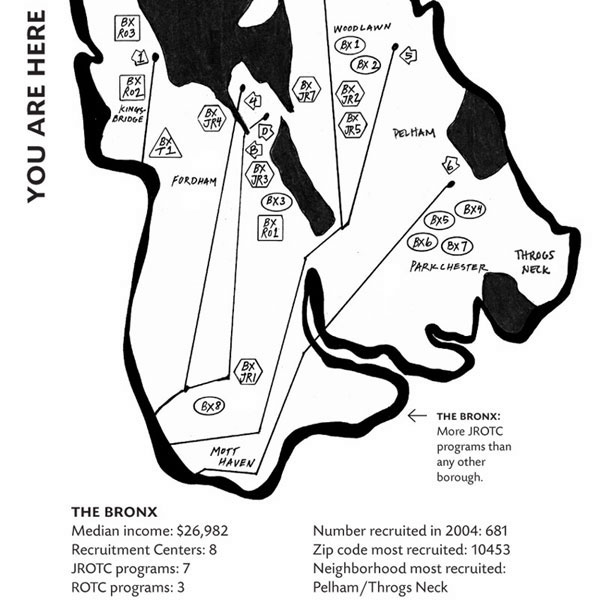| THEME#5 >>> RACIALIZATION OF SPACE / SPATIALIZATION OF RACE | Next Theme / Themes Home |

Detroit Do Your Thing! / Center for Urban Pedagogy (CUP)
There's a story people love to tell about Detroit. Beginning with the invention of the assembly line, it traces Detroit's rise to Fordist paradise, notes the city's role in the making of the modern middle class, and then waxes poetic about some urban version of the American dream that a combination of industrial restructuring, anti-urban federal policies, and racism brought to an untimely end. The story's next chapter is thus about Detroit's decline; it takes us through deindustrialization, race riots, and the suburban exodus, and ends by speculating that Detroit is a city that has "outlived itself." In a postscript, the story's author, who is now walking around "the ruins of Detroit" points to the trees that are growing through streets and factory floors, the houses that have crumbled into the earth, and the deer population that has colonized the downtown and concludes that one day, Detroit will revert to nature. However spectacular this story is, we'd like to offer another reading. If left to its own accord, Detroit will return to the suburbs. Today it's the suburbs, not the indigenous landscape, that you can count on to fill in whatever hole civilization has created. Simply put, it's the most ravenous, opportunistic force around.
However Unspectacular stems from our conviction that the suburbanization of Detroit doesn't have to follow national trends. A major component of our strategy is to imagine an urbanism based on risk management, where geographic risks – for example, being born in center-city Detroit – are distributed evenly throughout the Metropolitan area. We suggest a more physical strategy that builds upon an emergent New Suburbanism to diversify the housing mix, income level, and programs of center-city Detroit, but also a more policy-level strategy that allows Detroit's residents to spread their risks amongst larger geographic areas.

Detroit's Underdevelopment: Separation > Divesture > Erasure > Encampment / Adrian Blackwell
1:100,000 > beyond the fray
1:30,000 > zone of contestation
1:10,000 > built (and unbuilt) formThis project is an attempt to map the relationships between social forces and physical spaces in the city of Detroit since the Second World War.
In contrast to both, this project begins to spatialize recent work of Thomas Sugrue, author of The Origins of the Urban Crisis and June Manning Thomas, author of Race and Redevelopment. Both argue that the powerful effects of racism shaped the city's underdevelopment as sharply as economic forces. The purpose of these maps is to gain a better purchase on the historical factors that lie beneath the situation of contemporary Detroit, as a means to consider the serious action required to transform the metropolitan area into a more equitable social space. Techno innovator Derrick May calls Detroit "a horribly designed city." Specific design decisions, many of them influenced by design professionals, have contributed to the construction of a city that is deeply divided by affluence and poverty, whiteness and blackness. As a result, living in different locations means completely different access to education, healthcare, personal safety and employment. This tragic underdevelopment was accomplished through the use of an overlapping complex of paranoid strategies, each tied to explicit policies of development and often initiated and supported by both government and corporate lobby groups. Here I am trying to consider four strategies that are distinctly spatial: separation, divesture, erasure and encampment.

A People's Guide to Los Angeles / Laura Pulido, Sharon Sekhon, Laura Barraclough, Dan HoSang, Lorena Munoz, Roberto Morales, Alex Tarr, Priscilla Ovalle, Robert Drwila, Steven Murashige, Tony Osumi, Wendy Cheng
A People's Guide to LA is an attempt to map sites of racial and class struggle in Los Angeles' history and landscape. Looking at the history of California, and especially Los Angeles, it is clear that race has been one of the central forces shaping the development of the region. From the arrival of Spanish missionaries, to the development of Chinatown, to the beating of Rodney King, race is one of the key factors that have influenced the region's economy, landscape, and history. While there have been some efforts to memorialize the history of various communities of color, as seen in the Dunbar Hotel, Olvera Street, and Little Tokyo, these sites emphasize the contributions and historical experience of particular groups. While we think this is invaluable, we also think there is a need to emphasize struggle, because when you think about, that's what race is really all about.
By thinking of race as a power relationship, one can begin to see how it is fought and contested: How will particular groups be categorized? What groups will be included and excluded from neighborhoods and the body politic? What rights will various groups be accorded?
Whenever such matters are contemplated, you can be sure that people will resist efforts to marginalize them. Sometimes they fight out of self-interest and because their dignity is being assaulted, other times they resist out of solidarity or because they realize that they are responsible for their sisters and brothers. We felt that this dimension of Los Angeles's landscape and history was missing.

The New Yorkers' Guide to Military Recruitment in the 5 Boroughs / Friends of William Blake
According to the New York Times, nearly one in five U.S. Army recruiters was under investigation in 2004 for offenses varying from "threats and coercion to false promises that applicants would not be sent to Iraq." One veteran recruiter told a reporter for the Albany Times Union, "I've been recruiting for years and I don't know one recruiter who wasn't dishonest about it. I did it myself."
This free 64-page, pocket-sized book includes everything a New Yorker needs to know about military recruitment and resources for counter-recruitment in NYC. Profiles of former soldiers sit side-by-side information on the enlistment contract, military myths, the No Child Left Behind Act, action/legal resources, a Harper's-style index of facts, and much more. At the heart of the book is an opt-out form that students can tear out, fill in, and hand over to their school administrators to prevent their contact information from being released to recruiters.
Download the guide or find out where to get it in your neighborhood.
| THEME#5 >>> RACIALIZATION OF SPACE / SPATIALIZATION OF RACE | Next Theme / Home |